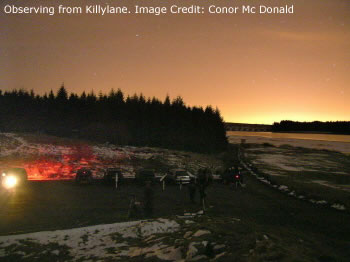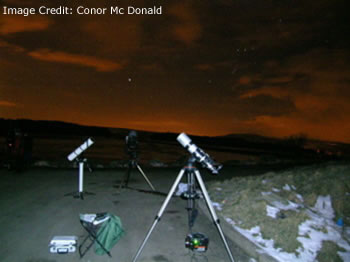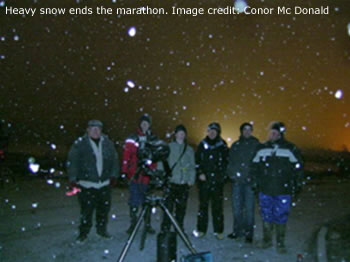
 |
|
 |
On Friday 3rd March the (East Antrim Astronomical Society) held their annual Messier Marathon from Killylane reservoir outside Larne. Tonight was to be my first serious attempt at bagging all 110 (technically 97 from our location) of Charles Messier's deep sky objects. On years past I had spent many hours training for this event on my own from my back garden undertaking numerous 'mini' marathons or 'sprints' and now was the time for the big event which I had been looking forward to for some time.
This was my own first time observing from this new location and the environment left a deep impression on me. This was a very dark site surrounded by snow coated hills and pine trees where we set up our equipment over looking the frozen lake which made a beautiful scenic location for a nights observing. The night was dry, calm and VERY cold with a clear sky and good transparency. But despite the low temperatures, I was certainly excited about the evening of observation. Whilst most people might have been keeping warm indoors, watching TV or playing online games at sites like http://www.partycasino.com/, I was glad to be spending the night in such a beautiful location. There was certainly lots to see, even before the Messier Marathon began. The waxing crescent moon with earth shine was a stunning sight in Pisces and I could see its shimmering reflection on the lake itself.
 |
There was between 13-14 observers in all using a wide range of equipment from cameras, Binoculars, Refractors, SCT's and Reflectors both with and without GO -TO technology. I used my Meade 8" LX10 deluxe F/6.3 at 49X and upgraded later to a 2" Diagonal and 2" 32mm SWA eyepiece for a wider field. (thanks for the lend Mark). As the sky slowly darkened we spotted a brilliant passage of the ISS silently blaze across the sky passing near Orion’s Belt and skirting the bright star Procyon in Canis Minor. This has to be one of the brightest ISS passages I have ever seen. I got a text message from Kevin Black who was then observing from Belfast informing me that he had observed a beautiful Aurora for 45 minute's duration however we could not see anything from here possibly due to the pine trees that blocked the low northern sky. Thanks for the text Kevin.
I then began my own Messier Marathon before twilight ended (Observations recorded in local time = Universal time + 1 hour)...
M77 19.30 - Observation made in twilight, Galaxy located approximately 20* SE of Moon. Compact fuzzy spot with brilliant stellar nucleus with sharp edges near a similarly bright field star. Slightly hazy sky illuminated by moonlight. Easy object which I showed to others.
M79 19.35 - Located low in the south in poor trans. A circular fuzzy spot with bright core. No stars resolved within cluster. Shown to other observers.
M41 19.40 - Nice large bright cluster with two red Carbon stars at centre. Shown to others. Not seen with naked eye due to haze.
M39 - 19.50 - Loose scattered open cluster with white suns. Also seen with naked eye over a distant hill.
M31, M32, M110 19.52 - Beautiful galaxy trio. M31 filled low power field, suspected outer spiral arms and dark dust lanes. Shown to others. Stephen Mc Govern and I agreed that M110 was our favorite. M31 seen with naked eye.
M93 19.55 - Rich open cluster in Puppis. Low in south in haze and poor trans. Member stars seemed clustered towards west.
M42, M43 19.59 - Both nebulae in same FOV. M42 a beautiful blue object with vivid 3D like structure and well defined dark fish mouth. Shown to other observers. Everyone was impressed with this object.
M78 20.00 - Blue wedge shaped puff of mist with two bright stars of same magnitude at centre. Shown to others.
M1 20.02 - Nice object well placed in sky. Definite filament - like structure observed. Shown to others.
M76 20.07 - Cousin of infamous M27. Small in size and easy to see in rich star field.
M45 20.30 - Examined at 49X in 8”. Tried for Merope nebula however poor transparency prevented detection. Best seen with 10X50 binos and naked eye.
M37, M36, M38 20.45 - All three clusters seen within same field of Conor’s 10X50 binos. Seen M37 + M36 with naked eye. All three observed in 8” with M37 the most spectacular of the trio. Conor also observed M37 through the 8” and was impressed.
M74 20.55 - Moon very close to this object. Was not detectable in 8”. Observed it using Marks Meade 10” Go -To. A VERY difficult object in the bright haze and barely brighter than the back ground sky. Seen using averted vision.
M34 20.55 - Weak, spread out open cluster. Unimpressive in 8”. Seen with naked eye and best in binoculars. Also shown to Conor.
M35 21.10 - Very nice, compact rich cluster. NGC companion cluster also observed . Seen with naked eye.
M44 21.10 - Loose concentration of blue stars in 8”. Observed this cluster along with Saturn in same field using Jonathan's 10X50 binos. Looks like large tailless comet with naked eye.
M67 21.12 - Very nice compact dense beautiful open cluster. Best open cluster in Cancer and much more spectacular than its famous Beehive cousin to the north.
M33 21.28 - This large low surface brightness galaxy could not be seen in 8” due to haze and moon light. Central region observed through Marks 10”. Also seen bright HII region within outer spiral arms.
M52 21.40 - Observed through Stephen Mc Governs 4” Celestron GO-TO refractor. Lovely object in rich Milky way star field. Conor also observed it.
M46, M47 21.40 - Spotted both these open clusters with naked eye as two fuzzy spots side by side through car windscreen while warming up inside!
Total Messier Objects Observer = 26/110
As the body of Leo the 'lion' rose higher into the eastern sky I faintly spotted the Gegenschein (elusive counter glow) as a + 10* oval grey patch of light to the east of Regulus. It was a difficult object due to weak moonlight in the west (16th Observation).
I was feeling very sick due to the cold so I spent a little time warming up in the car. I had a good chat with various observers about comets, telescopes and possible life in the Universe then I headed back outside for another session. A very bright blue double flash lit up the entire sky and ground which got everyone's attention. I believe this was distant lightning. I seen a nice number of swift meteors and a lovely golden Mag 0 sporadic meteor zip overhead.
 |
I was about to make a start on the rest of the Messier objects when clouds soon moved in to create overcast conditions followed shortly after by snow. We all gathered around and had a great chat waiting for clear skies however the snow got very heavy and so it was decided that we should retire for the night otherwise we would never make it out of here.
The drive home was very frightening at times due to low visibility and very heavy snow which rendered even the cats eyes on the road invisible. Overall it was a fantastic night and we are planning a second attempt later in the month. I also hope to observe a number of Meteor showers from this stunning location. This was my own brief personal account of the night. I look forward very much to the next one.
Martin McKenna